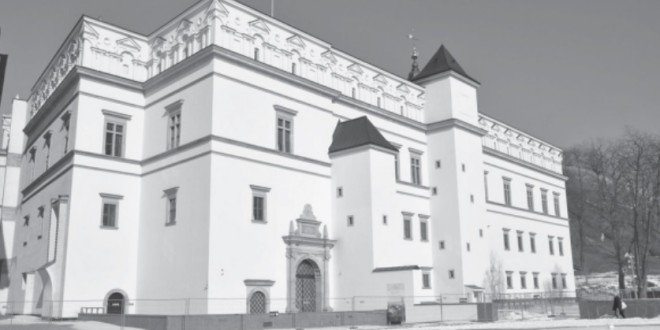BY JOLANTA KARPAVIČIENĖ

THE PALACE OF THE GRAND Dukes of Lithuania, which is now being reconstructed in Vilnius, embodies the whole course of Lithuanian history. The foundation signifies the beginnings of statehood in the thirteenth century and multiple layers of artifacts document the expansion of the Grand Duchy of Lithuania over the next several centuries. The remains of ruined walls mark the onset of political decline in the mid-seventeenth century and the loss of statehood at the close of the eighteenth. The grounds were witness to the birth and rebirth of the Lithuanian Republic at the beginning and end of the twentieth century. The current reconstruction of the palace corresponds with the reconstitution of Lithuanian statehood.
Archeologists found the remains of the former ducal palace, which was torn down two hundred years ago, at the end of the Soviet era. Largescale archeological excavations in the center of Vilnius in the late 1980s coincided with the emergence of the anti-Soviet resistance movement, Sàjūdis, and Lithuania’s declaration of independence in 1990.
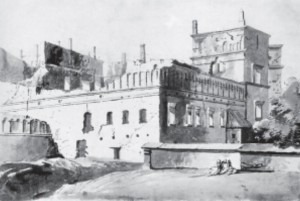
The archeologists uncovered the various strata of Lithuanian history— the seven hundred-year old ruins of the fortification walls of the castle at the foot of Gediminas Hill (before this dig, almost nothing was known about these walls), the original cellars and walls of the ducal palace that grew out of the old castle as well as remnants of buildings and streets of the old wooden Vilnius. The large number and variety of archeological finds surprised even the biggest skeptics. In Lithuania to date, in terms of scale and scientific importance, this is a unique archeological site.
After long and controversial discussions about how best to preserve this treasure of Lithuania’s historical and cultural heritage, a political decision was made to undertake a challenging and complex project. In 2000, the Lithuanian Parliament passed a law authorizing reconstruction of the palace and specifying its function. This was quite a rare event in the global context—the decision to rebuild a unique cultural heritage object, destroyed two hundred years ago, in its original location and to bring it back into the historical consciousness of the public. In this way, the newly independent state also sought restitution of its historical statehood.
The decision was made to construct anew, not to restore or rebuild—in essence, to use the large amounts of archeological, historical, and iconographic materials collected, as well as historical analogues, to reconstruct the historical residence of the Grand Dukes of Lithuania over the site as a cover or hood to preserve the archeological treasures below—the authentic stone and brick walls and the different cultural layers rich in archeological finds. These archeological features will become part of a museum exhibit—a unique way of preserving them in their original location.
Such a course of action has called for some complex and expensive engineering and architectural solutions, which have been admired by foreign experts. While visiting Lithuania, Prof. Dirk Syndram, Director of the Dresden Residential Castle, reconstructed in a similar manner after World War II, noted metaphorically that under the ground, in the center of Vilnius, the gold of Lithuania’s past lies hidden. The scientists and scholars, the architects and engineers of our country have found a way to extract that gold and bring it into the light of day, to preserve and restore this invaluable cultural heritage for the Lithuanian people and visitors from abroad.
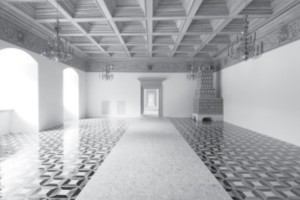
After becoming acquainted with our ducal palace reconstruction project, the engineer and architect Manfred Rettig, head of the Humboldt Forum, which is coordinating the rebuilding of the Royal Palace in Berlin, said that he was leaving Vilnius with qualms of conscience because the German Parliament chose an easier and cheaper way, deciding not to include various archeological layers in their future museum exhibit spaces.
When reconstruction work on the palace began in 2002, intensive archeological work continued. Few cities can permit such a luxury. For two decades since 1988, over two hectares in the center of the city were carefully excavated and studied. The cultural strata went down as far as eight meters. Archeologists and construction workers had to work under difficult conditions. This part of the city is on the delta of the Vilnelė river, which gave its name to the city of Vilnius. Thus the groundwater level is high here and the soil moist. The reconstructed palace stands on reinforced concrete piles placed on a moraine at a depth of eighteen meters. The complex natural conditions presented a challenge not only to our present-day engineering specialists to find unique technological solutions, but to our ancestors as well, who used local wood for piles. These pine logs were constantly under water, and thus survived for centuries and now bear witness to Lithuania’s history. Dendrochronological analysis can determine very accurately when the wood was cut and used in the construction of the castle or residential palace. This is very important data for the history of Lithuanian architecture and material culture.
While digging in the territory of the former ducal palace, archeologists discovered over 300,000 artifacts. Not only is the number of artifacts impressive, but their quality and variety as well. Because of the damp soil, material culture objects, which normally do not survive in the ground, did so very well. These include wood timbers and wooden artifacts, leather and textile articles, and various other organic remains. Using these materials and other archeological finds and historical data, researchers have shed light on various aspects of Lithuanian history, determined the geographical bounds of the country’s major trade routes and external cultural ties, and revealed the everyday life of the ducal palace. Sometimes the finds have led to fundamental revisions of accepted historical propositions.
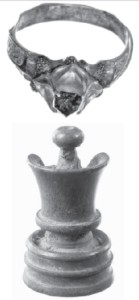
After doing comparative studies, it became clear that brickwork masonry in Lithuania began earlier than once postulated. Fortifications at the foot of Gediminas Hill dating from the end of the thirteenth century show that the barely fifty-year-old state was rapidly developing its technological capabilities and was already familiar with masonry construction. Lithuanians used the Baltic or Wendish bond, which was common throughout the Baltic region, in their brick masonry. The castles of the Teutonic Knights in the current territories of Poland and Latvia were built using analogous techniques. Lithuanians and their neighbors borrowed these technologies, but manufactured their own bricks and other construction materials. Archeologists working on the grounds of the ducal palace found the defensive wall, one of several towers, and a residential building that will greet future museum visitors. As they descend into the museum’s vestibule, visitors will enter into the interior of the oldest known Lithuanian brick castle and will come into virtual contact with the beginnings of Lithuania’s material civilization.—
By the fourteenth century, Lithuanians already knew how to carry out large-scale irrigation projects. A canal was dug to change the main course of the Vilnelė river to its present one and the old riverbed was also redirected. Thus a ring of water was formed—the Neris river on one side and the Vilnelė looping around the other three sides, in essence forming a protective island for the Vilnius castles. The swampy land was filled in and reinforced, forming the thirteen-hectare territory of the Lower Castle complex. It was surrounded by a brick wall with guard towers and gates to create a defensive whole that included both the Lower and Upper Castles. Thus fortified, the Vilnius castles were able to withstand attacks by the powerful Teutonic Knights. A participant in an unsuccessful siege in 1390 was Henry Bolingbroke, the Earl of Derby, who later became King Henry IV of England.
With the expansion of the state— at its peak the Grand Duchy of Lithuania stretched from the Baltic to the Black Sea—the representational and administrative needs of the grand dukes grew considerably. At the end of the fifteenth century, the defensive Lower Castle was rebuilt as a residence in the Late Gothic style. During the sixteenth century, it was transformed gradually into a luxurious Renaissance palace, which took on early Baroque features at the beginning of the seventeenth century.
Lithuania had entered the European trade orbit and its cultural space. Archeological finds at the ducal palace show that glass, luxury goods, and even musical instruments were imported from Venice, Genoa, and other Italian cities. Sandstone, limestone, marble and other expensive construction materials were imported from the island of Gotland, the Netherlands, and Sweden. Expensive textiles, spices, exotic jewelry, and porcelain came from the East via Europe or the Crimea. Some of the archeological finds were made of imported wood, such as a fifteenth century chess piece, a mirror frame, and a comb. Researchers were surprised to find that leather shoes with soles made of Portuguese cork were worn in Vilnius five hundred years ago.
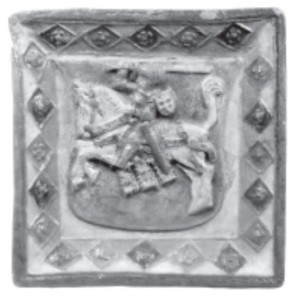
Lithuania was not only an importer. From the fourteenth century, it was an exporter of wood to Western Europe. Such great quantities of wood and wood products were exported via various water routes that English scholars call the lumber imported from the East over several centuries, simply, Baltic oak.
Conditions favorable for the growth of cultural ties were also enhanced through dynastic marriages. Lithuanian rulers were related by marriage with all the ruling families of Europe. For example, Anne of Bohemia, the great-granddaughter of Lithuanian Grand Duke Gediminas, during whose reign in 1323 the capital of Lithuania was first mentioned in written sources, was married to King Richard II of England.
Lithuanian engineering and technological achievements are evident in the waterworks developed for the ducal palace. A wooden water pipe was connected to the palace reservoirs and to windmills at the branches of the Vilnelė river to regulate the level of the groundwater. A considerable number of these wooden objects —well casings, pieces of pipe, and others—have survived, are being conserved, and will eventually be displayed in the museum. This harmonious water system functioned smoothly until the middle of the seventeenth century, when it was destroyed by the invading Muscovite army and never rebuilt. After six years of Russian occupation, the Palace of the Grand Dukes also never recovered. Ravaged and plundered, it stood for another century and a half, until the Russian tsar finally gave orders to tear it down completely in order to erase it from the historical memory of the Lithuanians.
Nevertheless, archeological finds in the palace grounds attest to another side of the Lithuanian military story and its military contacts. Numerous finds of weapons, armor, and pieces of armament have forced scholars to reexamine some of their earlier hypotheses that the Lithuanian military was mostly influenced by the East. In fact, these finds point to a heavy Western influence as well as local ingenuity, for some of the weapons and armor found in Vilnius have no European analogues.
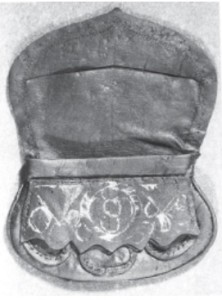
Among the archeological finds in the palace territory are some real treasures—highest-quality gold rings with precious stones, valuable jewelry as well as jewelers’ tools. Scholars especially value the numismatic finds. In terms of both quality and quantity they have no analogues in Lithuania or abroad. The number of coins found runs into the thousands. They add considerably to our knowledge of the sources and scope of Lithuania’s monetary policies and to the breadth of its trade. There was even trade with Scotland. In Vilnius, archeologists found Scottish pence from the first half of the seventeenth century.
An invaluable treasure is the collection of ceramic tiles. Tens of thousands of artifacts representing various eras and styles—Gothic, Renaissance and Northern Mannerism— reveal the close ties that Lithuania’s grand dukes and noblemen had with European artists and artisans. After restoration and reconstruction, it became evident that the subject matter of some of the tiles was based on engravings by such famous artists as Lucas Cranach and others. The biblical subjects and heraldic motifs of other tiles await the close scrutiny and attention of art historians and other specialists.
Undoubtedly, future research on these artifacts will reveal many treasures of Lithuanian history and broaden our knowledge about our country’s cultural horizons. But most importantly, these treasures will be displayed in the new palace museum and will be accessible to the Lithuanian public and foreign visitors to Vilnius. The historical residence of Lithuania’s rulers, from which Lithuania reached out to Europe and through which European influences came to Lithuania so long ago, will once again come alive.
 DRAUGAS NEWS Lithuanian World Wide News in English
DRAUGAS NEWS Lithuanian World Wide News in English
